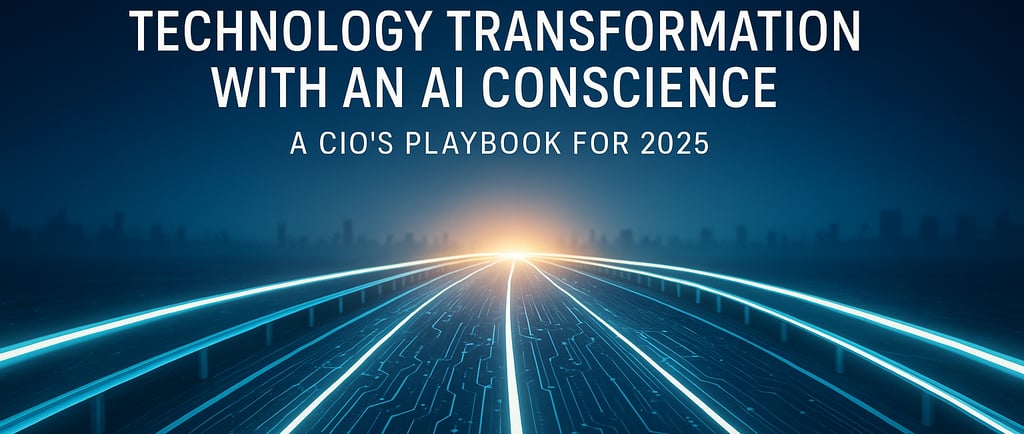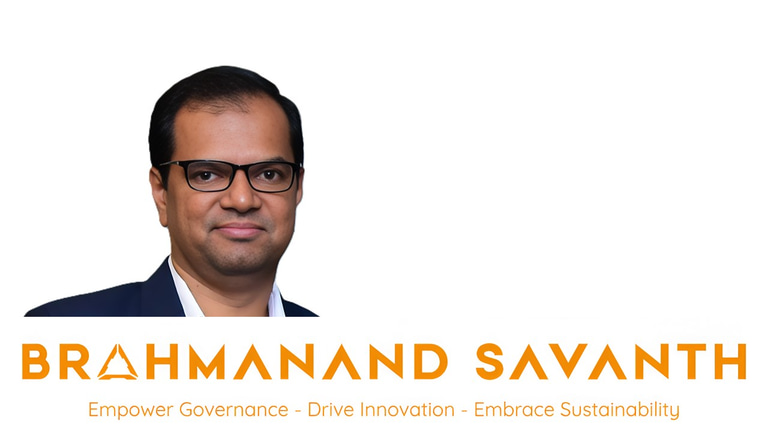Technology Transformation with an AI Conscience: A CIO Playbook | Aug 2025 | Published on GreatCIO.com
Explore how CIOs can balance speed and trust in the age of AI. This blog offers a fresh playbook on technology transformation, highlighting governance frameworks that keep innovation ethical, scalable, and future-ready.
BLOG
Brahmanand Savanth
8/20/20253 min read


Technology Transformation with an AI Conscience: A CIO Playbook
Aug 2025
By Brahmanand Savanth
Over the past decade, we focused on building the digital highways that made connected world possible. The next few years, however, are not just about going faster—they are about driving responsibly at scale. AI has moved beyond being an experiment, it’s now the engine powering processes, channels, and decisions across the business.
But true advantage will not come from the technology alone. It will come from how we reimagine our technology foundations and govern AI with the same discipline we apply to finance, security, and safety.
I describe this as a “Two-Speed, One-Ethic” approach: modernize the core with the efficiency of an enterprise, innovate at the edge with the agility of a startup, and ensure both are grounded in a governance ethic that safeguards people, reputation, and long-term value.
When Transformation Meets Reality
I had the privilege of leading technology operations across 70+ enterprise clients spanning multiple industries—where Availability, Compliance, and Efficiency were non-negotiable. In that role, the toughest challenge was not infrastructure—it was trust.
In one program, consolidating IaaS operations across verticals meant breaking silos, enforcing consistency, and embedding automation as the invisible backbone. The outcome? Faster recovery times, fewer escalations, and a system that scaled quietly in the background.
In another case, we rolled out an AI-powered virtual assistant to handle thousands of service requests. At first, it seemed like just another chatbot. But when we baked in governance—masking, policy triggers, escalation workflows—the assistant became a trusted co-worker, not a liability.
These learnings convinced me that we as leaders must architect transformation with a governed AI conscience—because speed without control is just risk accelerated.
The Two-Speed, One-Ethic Transformation
Speed 1: Renovate the Core (12–24 months)
Platform the enterprise. Just as we unified IaaS estates, We should consolidate onto cloud-native platforms with unified observability across cost, security, and even carbon footprint.
ERP, but with AI inside. Imagine finance close, supply planning, or compliance workflows with AI copilots that work only because data lineage and access rights are watertight.
De-risk legacy with automated guardrails. Policy-as-code layers—PII redaction, prompt filtering—should sit in the service layer, not as afterthoughts.
Framework Lens: This is where ISO/IEC 42001 (the first global AI management system standard) becomes invaluable. It extends the rigor of ISO 27001 (security) into AI by asking Information Officer to document purpose, align risk, and ensure continuous monitoring. In my IaaS unification journey, the same principles applied—structured governance embedded at every layer is what made transformation sustainable.
Speed 2: Invent the Edge (quarterly cycles)
Value sprints, not model sprints. In my AI assistant rollout, success came not from accuracy scores, but from measurable reductions in service response times and escalations.
Tiny models, big impact. We don’t need “the biggest model”; they need fit-for-purpose models with deterministic fallbacks.
Co-create with customers. Edge innovation works when customers are invited into safe sandboxes before full-scale release.
Framework Lens: NIST AI Risk Management Framework (RMF) is my guide here. Its four verbs—GOVERN, MAP, MEASURE, MANAGE—fit neatly into quarterly innovation cycles:
Govern the intent up front,
Map the data and risks,
Measure performance & bias in pre-prod,
Manage by building kill-switches and fallbacks.
This turns innovation from “experimentation with hope” into “experimentation with accountability.”
One Ethic: Govern Everything, Once
Whether it’s IaaS automation, AI copilots, or a new data lake, one governance approach should oversee all: policy as code, unified risk controls, and continuous transparency.
Framework Lens: India’s Digital Personal Data Protection Act (DPDP), 2023 forces enterprises to move from “data-hungry AI” to purpose-bound, consent-driven AI. For CIOs, that means every dataset feeding AI should be tagged with lawful purpose, consent status, and retention expiry. In my AI assistant project, this discipline helped us build trust with employees—because they knew the system wasn’t learning beyond its remit.
Lessons From the Frontline
Don’t separate transformation and governance. In my IaaS story, operational improvements stuck only when monitoring, reporting, and escalation became part of the process, not afterthoughts. Frameworks like ISO 42001 and NIST AI RMF show how to institutionalize this.
Governance earns adoption. Teams trusted the AI assistant only when they saw that DPDP-like privacy and fallback rules protected them. Adoption, not accuracy, was the real win.
Celebrate safe failure. In high-risk clients, we measured success not only in uptime but also in graceful degradation—how quickly systems failed safe. AI copilots should be judged by the same metric.
Closing Thought
Technology transformation is no longer about faster, cheaper, better—it is about responsible, governed, and trusted. AI powers the mind. Leadership fuels the heart. When they unite under a shared ethic, transformation becomes inevitable—and safe.
As CIOs, our role is not just to implement platforms or models, but to design systems where safety and speed co-exist, and where governance is not a barrier but a bridge to scale.
Transform fast, govern well, and let trust be your true competitive edge - Brahmanand Savanth
https://greatcio.com/profiles/blogs/technology-transformation-with-an-ai-conscience-cio-s-playbook
